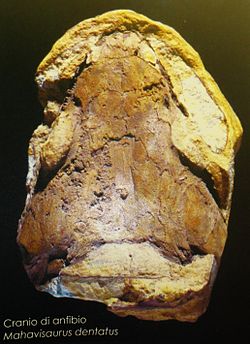| Mahavisaurus Temporal range: Early Triassic, | |
|---|---|
 | |
| Skull | |
| Scientific classification | |
| Domain: | Eukaryota |
| Kingdom: | Animalia |
| Phylum: | Chordata |
| Order: | † Temnospondyli |
| Suborder: | † Stereospondyli |
| Family: | † Rhytidosteidae |
| Genus: | † Mahavisaurus Lehman, 1966 |
| Species | |
| |
Mahavisaurus is an extinct genus of rhytidosteid temnospondyl from the early Triassic period (Induan stage) of Iraro, Madagascar. It is known from the holotype MNHN MAE 3037, a nearly complete skull, recovered from the Middle Sakamena Formation. This genus was named by J. P. Lehman in 1966, and the type species is Mahavisaurus dentatus. [1]

